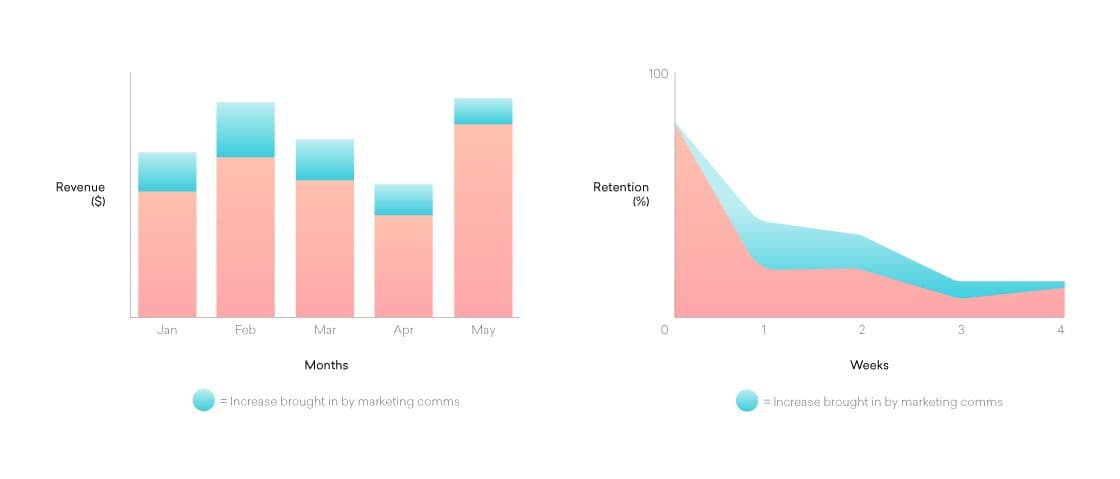8 Benefits of Measuring Your Email Marketing Program
Published on May 21, 2019/Last edited on May 21, 2019/9 min read


Michelle Huang
Email and Messaging Lead at CanvaThink about all the effort and work and time you put into your email campaigns—and all that those campaigns make possible. They drive purchases, upgrades, larger order values, and nudge repeat customers to engage more frequently. When you’re able to clearly measure and calculate the increase in customers and revenue that your marketing comms have brought in, it can be transformative. You have increased strategic clarity, many blockers disappear, and your decisions can be better substantiated. But too often marketers don’t do enough to prioritize measurement.
I get it. It can be difficult for marketers to put a clear number behind that real-world impact. But I’ve learned on my journey at Canva that creating a successful email marketing strategy is just as much about prioritizing effective measurement as it is about knowing what subject lines work, what triggers spam filters, and how to successfully use personalization, segmentation, and deep linking. And when you’re able to put a concrete revenue or retention number—think “Our marketing comms increased company revenue by $58,871 this month”—to your marketing program, all sorts of possibilities open up.
The 8 Major Benefits of Measuring the Impact of Your Messaging Channels
Here’s the thing: Measuring empowers you to communicate clearly, effectively, and powerfully. That makes it easier to show others in your company the impact and importance of the messaging channels your team owns, and helps to justify your team’s need for additional resources, among many other benefits. Let’s take a look at the eight major positive outcomes that can result from prioritizing measurement:
1. You can start putting tangible numbers to your marketing comms
When you understand your brand’s baseline performance in terms of retention, revenue, or other key metrics, it makes it possible to clearly understand and communicate the impact of your efforts and the importance of the messaging channels you’re using. For instance, if you know that your company usually has a 58% 28-day rolling retention rate (determined by implementing an email holdout group who don’t receive your email program), but that users who received marketing emails have a 66% rolling, you can make an effective case that your email program is having an eight-point positive impact on retention on average.
Once you have these sorts of numbers in hand, you can use them to support summary statements of your findings—for example, “in the month of January 2019, emails and mobile messaging (SMS + push + in app messaging) increased revenue by $58,871”—as well as charts that can help to effectively illustrate and communicate the positive outcomes of your marketing comms.

2. You can grow your marketing budget
Once you have meaningful numbers that track the impact of your marketing comms, you’re going to be better equipped to extrapolate the potential future impact of your efforts. In turn, being able to pull together how your program is performing and how it is likely to perform going forward is essential if you want to make a strong and compelling for additional resources.
What would that look like? Let’s walk through a theoretical example and see.
- Right now, your brand’s ecommerce newsletter is bringing in $80k in monthly revenue
- Preliminary tests suggest that personalizing the newsletter would:
- Increase the average spend per customer by 10%
- Boost the number of customers making a purchase by 15%
- Given that, if your brand invests the time and resources needed to personalize its newsletter, it would reach $101k in monthly revenue, increasing revenue by $20k per month and $240k per year
- Therefore, if more resources—for instance, hiring an additional head for your team—are needed to personalize your newsletter on an ongoing basis, your company can make a clear, cost/benefit analysis of those potential costs and their likely impact
(One thing to note—the above example is built on a number of assumptions, including that there would be similar conversion rates for all campaigns. In reality, impact and the increase brought about by marketing would likely be lower, due to factors like decreasing returns to scale.)
3. You can get your team’s requests prioritized
In any fast-growing company, there are always a lot of high-priority projects being worked on simultaneously. While that allows a brand to move fast and innovate, it can also make it difficult for Marketing teams to ensure that their needs are addressed. But when you’re able to measure and communicate the success of your marketing communications has had on core company KPIs and predict the expected future impact of proposed marketing initiatives, it’s a lot easier to get your team’s requests prioritized.
That’s key. With buy-in from colleagues and other teams within your organization, more advanced marketing tools and tactics can come into play, including:
- Automating personalized content
- Automating localization and translation of messages to a global audience
- Faster and better data pipelining
- Gathering valuable additional customer data points
- Personalizing the content you provide using machine learning
- Access to more sophisticated ESPs, data visualization tools, and deep linking technologies, among other solutions
4. You can bolster respect for the channels you control and your work with them
These days, emails are ubiquitous—in fact, between 2014 and 2018, the average office worker received about 90 emails a day and sent around 40 business emails. But because they’re so ever-present, it’s easy for people to fall into assumptions about these channels, even though sending marketing emails at scale is vastly more complex than shooting your friend an email.
But by measuring the impact you’re driving with marketing comms, you can demonstrate to other teams and key stakeholders that email is truly a powerful, effective channel for communicating with customers.
Plus, you’ll be better equipped to communicate the thinking behind your strategy and areas of focus. For instance, you could show others why you’re reluctant to launch a certain campaign by showing that previous attempts didn’t significantly boost engagement but did result in higher than average unsubscribes.
Having this kind of information on hand can also help marketers make a case against actions that could be harmful to their overall strategy. For example, if you can put a number to the cost of being blacklisted by ISPs and the time it will take to re-warm your IPs, it’s easier to sell internal stakeholders on the importance of avoiding email blasts in order to maintain a strong sender reputation.
5. You can align your areas of focus with the ones that drive the highest impact
Measuring the impact of each campaign you’re sending will help you identify which 20% of your campaigns are driving 80% of the impact, and allow you to align your areas of focus with the areas that have the biggest upside. Once you’ve identified your highest impact campaigns, you can start to:
- Optimize these campaigns: Because these campaigns drive significant impact, every percentage point increase is likely to meaningful and substantial to your marketing program as a whole.
- Scale these campaigns: By increasing the frequency of the sends or expanding the audience size of your most effective campaigns, you can see more upside—but make sure you keep an eye on your conversion rates, since there are often decreasing returns beyond a certain scale.
6. You can identify and action on your worst-performing campaigns
While you may have a great number of different email campaigns live and running, chances are that most of those campaigns are driving little or no impact when it comes to the success of your marketing efforts—but may well be contributing to your unsubscription numbers, send after send. Becoming aware of the impact of each campaign you send makes it an easier call to terminate ineffective campaigns, or to identify opportunities where you can take the time and resources you were spending on middle-of-the-road campaigns to get more impact out of high-performing ones.
7. You can help guide decisions around investment in major projects
Some email initiatives require a lot of investment—in connection with copywriting, creation of visual assets, translations, builds, and even data pipelining—to reach their full potential. So you want to be confident that the projects you’re focus that effort on have ROIs high enough to justify the associated expense.
That makes measurement especially important. By prioritizing effective measurement, you have the ability to develop a data-informed view of your marketing comms and you know how much each campaign contributes to core KPIs, allowing you to answer questions such as “Should the weekly newsletters we send out—which require significant resource input—be continued as is, changed, or terminated?” To get those answers, you can run simple minimum viable product (MVP) experiments, measure the impact that these campaigns drive, and extrapolate future returns before making further investments or kicking off larger-scale projects.
8. You can report more effectively on your success as a team
There’s so much work that goes into developing a marketing program—from copywriting, asset creation, and email testing, all the way to analysis and data pipelining. It’s important for marketing, growth, and engagement teams to be able to translate all of that into actual meaningful numbers and prove the value that their work provides. It’s empowering when every team member understands the impact of their contributions and where they can make more of a difference in the future. Done effectively, it can do a lot to drive up morale and enthusiasm for the next round of optimizations, builds, and launches!
Final Thoughts
When you clearly measure and calculate the increase in customers and revenue your marketing comms have brought in, you solve some of your biggest problems. You have increased strategic clarity, your blockers disappear and your decisions are well substantiated.
For more information and tips around measuring and growing a high impact email and CRM program, subscribe here.
To dig a little deeper into email and what’s possible with this key channel, check out Next-Generation Email: Standing Strong In The Age Of Inbox Infinity.
Related Tags
Be Absolutely Engaging.™
Sign up for regular updates from Braze.
Related Content
View the Blog
The new inbox reality: How iOS changes are reshaping email marketing

Aparna Prasad

Experience optimization: Turning data insights into better journeys

Team Braze

December 2025 Bonfire Marketer of the Month: Jagex’s Emma Oliver
